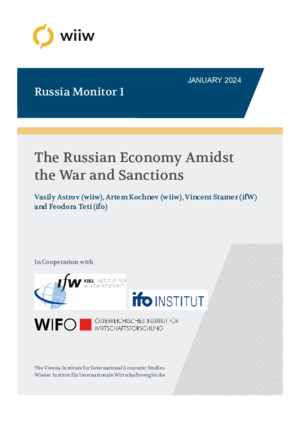The Russian Economy Amidst the War and Sanctions
Vasily Astrov, Artem Kochnev, Vincent Stamer and Feodora Teti
Russia Monitor No. 1, January 2024
25 pages including 1 Table, 6 Figures and 2 Boxes
The marked turnaround in Russia’s foreign trade in 2023 exerted strong downward pressure on the Russian rouble, which lost around 30% of its value. Global oil prices were declining in the first half of the year, the EU import embargo on Russian oil depressed prices even further; and on top of all that, Russia lost a large slice of what has historically been its main gas market – the EU. In response to a weakening rouble, the central bank has tightened policy markedly, although inflationary pressures have remained high so far. Otherwise, the economy continues its recovery on the back of domestic demand, driven in large part by (war-related) fiscal stimulus – officially estimated at around 10% of GDP in 2022-2023. Official data suggest that capacity utilisation has reached very high levels, the labour market is extremely tight, and unemployment has plunged to an all-time low. With no end in sight to the war, the current growth trajectory will likely continue for some time, despite the fact that the economy is suffering from increased labour shortages and is falling behind on the technological front, due to the Western sanctions.
Reference to wiiw databases: wiiw Monthly Database
Keywords: Russia, economic growth, labour market, monetary policy, fiscal policy, foreign trade, inflation, exchange rate, econometric modelling
JEL classification: C53, E24, E31, E52, E62, F10, F31, O52
Countries covered: Russia
Research Areas: Macroeconomic Analysis and Policy, Labour, Migration and Income Distribution, International Trade, Competitiveness and FDI
